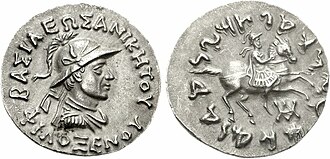Philoxenus Anicetus
Indo-Greek king From Wikipedia, the free encyclopedia
Philoxenus Anicetus (Greek: Φιλόξενος ὁ Ἀνίκητος, Philόxenos ho Aníkētos, meaning "Philoxenus the Invincible") was an Indo-Greek king who ruled in the region spanning the Paropamisade to Punjab. Philoxenus seems to have been quite an important king who might briefly have ruled most of the Indo-Greek territory. Bopearachchi dates Philoxenus to c. 100–95 BCE and R. C. Senior to c. 125–110 BCE.
| Philoxenus | |
|---|---|
 Portrait of Philoxenus | |
| Indo-Greek king | |
| Reign | 100–95 BCE |
| Died | Mathura |

Historians have not yet connected Philoxenus with any dynasty, but he could have been the father of the princess Kalliope, who was married to the king Hermaeus.
Coins of Philoxenos
Philoxenus struck several series of bilingual Indian silver coins, with a reverse of a mounted king, a type previously used as obverse by Antimachus II sixty years earlier and as reverse on rare types of Nicias. Whether the horseman was a dynastic emblem or a portrait of the king as a cavalryman is unclear. Several Saka kings used similar horsemen on their coinage.
Philoxenus means "lover of foreigners" or "hospitable" in Greek, and considering that his drachms were square, a feature that was rare among Indo-Greeks but standard for Sakas, this shows that Philoxenus had good connection and relations with the nomads that had conquered Bactria.
Philoxenus struck bronzes with female deity/bull, or Helios/Nike.
Philoxenus also minted some Attic-type tetradrachms (with Greek legend only), meant for circulation in Bactria.
Overstrikes
One overstrike is known, of Epander over Philoxenus.
Other coins
Philoxenus issued a variety of different coin standards, including some Attic coins, square Indian coins, and also circular bilingual coins with Greek and Kharosthi scripts.
- Silver coin of Philoxenus. Obverse shows the king wearing Boeotian helmet and diadem, with Greek legend: ΒΑΣΙΛΕΩΣ ΑΝΙΚΗΤΟΥ ΦΙΛΟΞΕΝΟΥ, Basileōs Anikētou Philoxenou, "Of the Invincible King Philoxenus". The Reverse with the king on horseback, and Kharosthi legend: Maharajasa Apadihatasa Philasinasa, "Of the Great Invincible King Philoxenus".
- Indian square coin of Philoxenus, with the obverse showing the king wearing Boeotian helmet, with surrounding Greek legend. The reverse shows the king on horseback, and surrounding Kharosthi legend.
- Another coin of Philoxenus. Reverse, showing the king in armour, wearing a crested Boeotian helmet, diadem, chlamys, and boots, while riding a galloping horse. He is also making a blessing gesture with his right hand.
See also
References
- The Greeks in Bactria and India, W. W. Tarn, Cambridge University Press.
External links
Wikiwand - on
Seamless Wikipedia browsing. On steroids.



